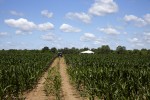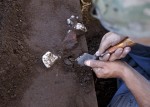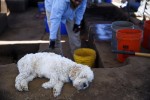 Under a cornfield in Cass County, Illinois, near where the Sangamon River flows into the Illinois, are the remains of a bustling Native American town that thrived from the 12th century through the 15th. The town had a central plaza, surrounded by three platform mounds, houses and defensive walls 10 feet tall and more than 1,000 feet long in each direction. Known as the Lawrenz Gun Club Site after a shooting club built on one of the mounds in the mid-20th century, the site has been studied by archaeologists and students from the Indiana University-Purdue University Indianapolis (IUPUI) every summer for six years.
Under a cornfield in Cass County, Illinois, near where the Sangamon River flows into the Illinois, are the remains of a bustling Native American town that thrived from the 12th century through the 15th. The town had a central plaza, surrounded by three platform mounds, houses and defensive walls 10 feet tall and more than 1,000 feet long in each direction. Known as the Lawrenz Gun Club Site after a shooting club built on one of the mounds in the mid-20th century, the site has been studied by archaeologists and students from the Indiana University-Purdue University Indianapolis (IUPUI) every summer for six years.
 It was the remains of the mounds that first indicated a community of the Mississippian culture had once inhabited the site, but the town ranges far beyond that, covering over 26 acres. IUPUI’s archaeology field school used remote sensing technology to establish the perimeter of the site and, since they can’t dig up the whole cornfield, to identify areas likely to contain artifacts. This excavation season alone they’ve unearthed 97 bags of archaeological material including projectile points, pottery of many different kinds from cookware to storage vessels to dishes, stone tools, plant and animal remains. Only once in the six years have they encountered a human burial. Officials were notified in compliance with federal law, the grave was reburied and the remains left undisturbed.
It was the remains of the mounds that first indicated a community of the Mississippian culture had once inhabited the site, but the town ranges far beyond that, covering over 26 acres. IUPUI’s archaeology field school used remote sensing technology to establish the perimeter of the site and, since they can’t dig up the whole cornfield, to identify areas likely to contain artifacts. This excavation season alone they’ve unearthed 97 bags of archaeological material including projectile points, pottery of many different kinds from cookware to storage vessels to dishes, stone tools, plant and animal remains. Only once in the six years have they encountered a human burial. Officials were notified in compliance with federal law, the grave was reburied and the remains left undisturbed.
“The last couple of years, we have focused inside the city’s walls. This year, we are looking at earlier structures, built before the walls were put up,”” [graduate student John] Flood said. “We are looking at an early house, about 5-by-5 meters in size, and how the city started to develop, trying to understand how the very early Mississippian community arranged their structures.”
For Flood, the most fascinating part of the multi-year investigation has been the huge, elaborate defensive walls built to protect the city.
“You have several portions of walls that were constructed at different points in time. Bastions and archers’ towers, you see a change in shape as they go from more circular to more rectangular in design. It shows they are really taking their time and thinking about their defensive fortifications,” Flood said. “We see that throughout all sorts of archaeology all over the world. Usually about the time you see agriculture, things like corn or maize, all of a sudden when you have food in one location, you find you have a need to protect that food.”“You also need to make your presence known,” Flood said. “If you’re coming down the river and see a big, fortified city with 10-foot walls and archers’ towers, that’s a big mark of presence. It says ‘we’re here, and we’re here to stay.'”
 Based on the artifacts unearthed so far as, the walls and the dwellings, researchers estimate that the village had a population of 400 to 600 people from around 1100 through 1450 A.D., making it probably the largest village in the area. The inhabitants grew crops, primarily maize, and also foraged wild resources from their environment, including seeds, grasses, nuts and marshelder, a ragweed relation with edible seeds that was cultivated by the earlier Kansas City Hopewell culture of Kansas and Missouri before maize displaced it. The surrounding area also provided abundant hunting and fishing. The IUPUI team has found a great many bones of fish, waterfowl and land mammals.
Based on the artifacts unearthed so far as, the walls and the dwellings, researchers estimate that the village had a population of 400 to 600 people from around 1100 through 1450 A.D., making it probably the largest village in the area. The inhabitants grew crops, primarily maize, and also foraged wild resources from their environment, including seeds, grasses, nuts and marshelder, a ragweed relation with edible seeds that was cultivated by the earlier Kansas City Hopewell culture of Kansas and Missouri before maize displaced it. The surrounding area also provided abundant hunting and fishing. The IUPUI team has found a great many bones of fish, waterfowl and land mammals.
A large community with impressive fortifications in a fertile location with plentiful plant and animal resources, the village likely traded with the great city of Cahokia, now the Cahokia Mounds State Historic Site, to the north. Like Cahokia and other known Mississippian communities, the Lawrenz Site met an abrupt end in the mid-15th century. Archaeologists believe a combination of the Little Ice Age and severe drought may have brought on repeated crop failures which drove the population to abandon their settlements and seek greener pastures. With no food left to protect, fortifications that once defended the stores become prison walls enclosing only the prospect of mass starvation.
 This season’s excavation will conclude at the end of the month. The 97 bags of artifacts and remains will be sorted, cleaned and analyzed in laboratory conditions back the university in Indianapolis. Every fragment is of interest as a potential source of information about the daily lives of the inhabitants of the prehistoric town.
This season’s excavation will conclude at the end of the month. The 97 bags of artifacts and remains will be sorted, cleaned and analyzed in laboratory conditions back the university in Indianapolis. Every fragment is of interest as a potential source of information about the daily lives of the inhabitants of the prehistoric town.
Wherever they moved to, there must be some chance that they died out because of the spread of Old World diseases from Mexico after 1500.
How can they estimate how high the walls were?
Just one of a number of “forgotten” aspects of early American settlement. https://en.wikipedia.org/wiki/Mound_Builders
Goooo Oscar.
A very helpful puppy!
I think of Egypt, the Middle East, the UK, etc. when I think of thrilling archaeological digs. This one’s a big deal for me because I grew up in Illinois. I live in California now, and wow—how great to see a photo of that dark, rich, Illinois dirt.
De Soto and his death march through the Southeast was the coupe de grace for the Mississippian culture, through penetrating it’s 15th century heart and sending European diseases via internal trade routes to rest of Mississippian world and it’s interconnected trading partners throughout the heart of North America.
The Gentleman of Elvas, a companion and chronicler of de Soto’s, makes mention of the abandoned ceremonial and village site in the interior of the Carolina’s where Spanish expeditions had penetrated a decade and a half earlier. Pigs and other livestock brought as food on the hoof, but especially pigs, which quickly go feral, brought by de Soto, long vectors of diseases in the Old World continued to spread disease long after the expedition marched away.
It is true that the Central Mississippian polities lost much of their vigor circa 1450, however the Southeastern Mississippians were at the apogee of their development in the century following. The Mississippians as a whole hadn’t declined, they simply shifted their nexus of power to the south and east.
De Soto and his aftermath destroyed the Mississippians. That American archaeologists continue to deny this despite the primary Spanish sources that contradict it, with explanations such as “floods, fires, earthquakes and droughts”, goes beyond the pale.
Do you suppose the Lewis and Clark expedition spread old world diseases too, or had the whole continent been pretty thoroughly exposed before then?
Lewis and Clark wintered at the Mandan Villages at the Great Bend of the Missouri on the way out and inadvertently introduced a number of diseases that ravaged the Mandan over the years. So the answer is yes, in that case.
However, French traders had been penetrating the Great Plains out to the front range of the Rockies for decades, with Spanish expeditions doing the same from Santa Fe. The Hudson’s Bay Company had crossed the continent roughly a decade before Lewis and Clark. All likely brought diseases with them, though they may have burned out quickly, we just don’t know.
It was sustained contact that really drove disease penetration and the massive loss of life that virgin populations experience when exposed to a new contagion.
Even the American born European population was vulnerable to the reintroduction of disease from the Old World due to infrequent contact with the mother countries early on. A couple of generations not exposed to a bout of whooping cough, could find themselves experiencing high death rates to what was a common and yearly disease where they originated from.
Malaria is especially interesting as the first European explorers brought in both their blood and their water. The mosquito’s that spread malaria are native to both New and Old World, however malaria itself was native only to the Old.
Columbus mentions that malaria wasn’t present in the islands on his First Voyage. On his second it had become established in parts of Hispanola. It’s likely it entered the America’s when the First Voyage took on water in the Bahamas, dumping the stagnant water and infected larvae from the Canaries.
Wiiliam McNeil’s “Plagues and Peoples” is forty years old, but it’s a true masterpiece on this subject. (and the Black Death to boot.) It’s well worth the read and an excellent introduction to disease vectors and their effect on human history.
Just as the Bubonic Plague was introduced to Europe by some traveller from the Middle East with utterly devastating results.